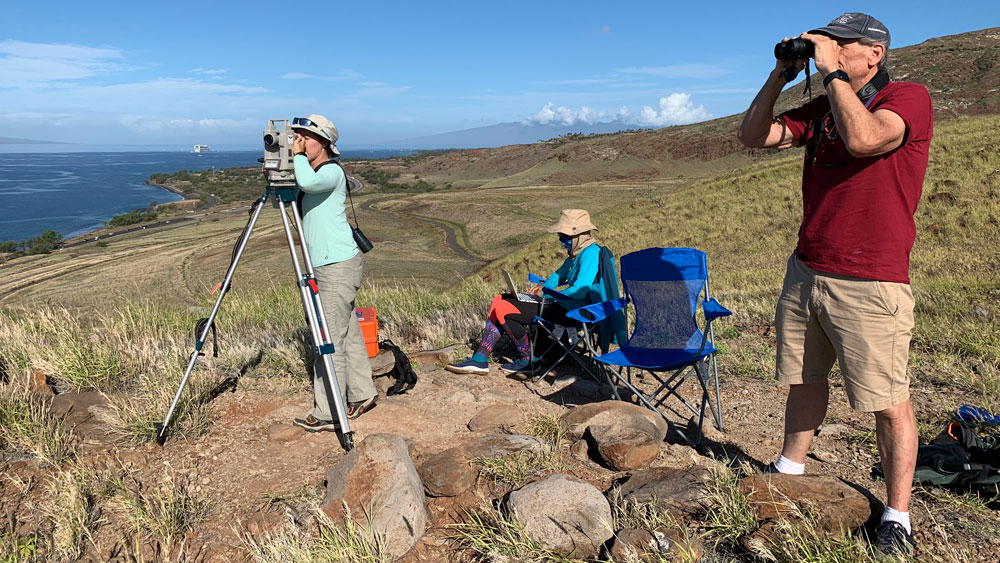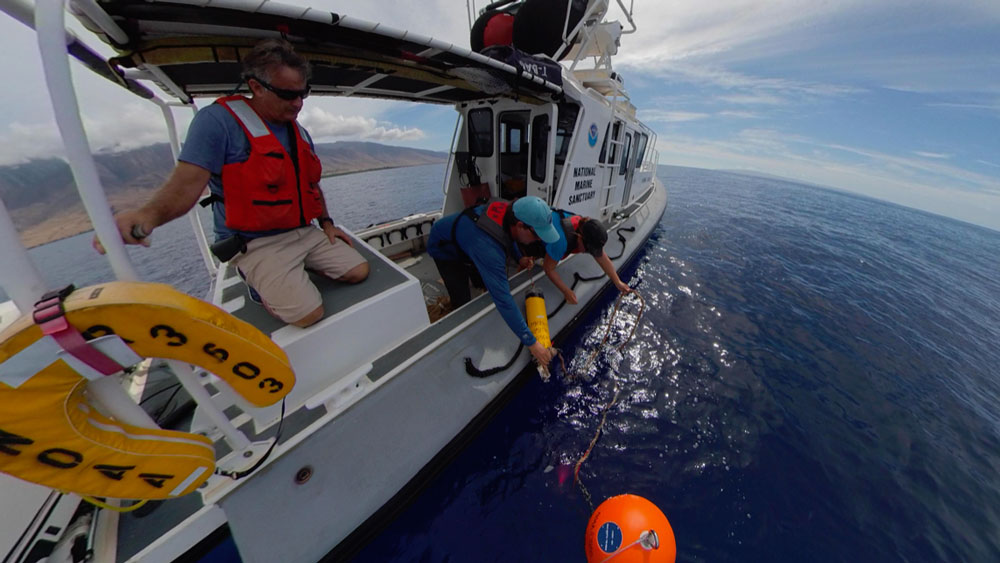Eavesdropping on Whales
How Acoustic Surveys Are Revolutionizing Humpback Whale Monitoring in Hawai’i
By Haley Randall
February 2021
Humpback whales have long fascinated us with their beautiful songs. Now, researchers are harnessing the power of these vocalizations to better understand and monitor these amazing animals in Hawaiian Islands Humpback Whale National Marine Sanctuary.
A Whale of an Effort
A humpback whale breaches in Māʻalaea Bay near Maui in Hawaiian Islands Humpback Whale National Marine Sanctuary. Photo: Tom Ayers/NOAA
Humpback whales (Megaptera novaeangliae) are one of the most captivating and beloved species of Hawaiian Island Humpback Whale National Marine Sanctuary. Wildlife enthusiasts from all over the world travel to the sanctuary each year to view and photograph these charismatic animals and perhaps even hear their evocative songs.
Every winter, thousands of humpback whales travel to the warm, shallow waters of Hawai‘i to mate, give birth, and raise their young. Hawaiian Islands Humpback Whale National Marine Sanctuary protects these whales and their habitat. From November through April, visitors to the sanctuary can see whales from shore and at sea.
These whales are famous for their vocalizations, which are a critical component of their ecology. Sound plays a tremendous role in the survival of humpback whales – as well as many other marine mammals, like dolphins and porpoises – because it is used for communication, orientation and navigation, hunting prey, and avoiding predators.
With sound playing such a crucial role in the lives of marine mammals like humpbacks, it’s important to monitor underwater soundscapes, which are the sounds heard in a particular region. Monitoring these soundscapes can supply us with a great deal of information – it can provide insight on whale population numbers, and can tell us where the whales are (and aren’t) within a certain region. To tap into the wealth of knowledge that is underwater sound, NOAA and the U.S. Navy have embarked on a four-year research endeavor, the Sanctuary Soundscape Monitoring Project (SanctSound), designed to help scientists and policymakers better understand what’s going on beneath the waves of national marine sanctuaries.
SanctSound encompasses multiple independent research projects throughout the sanctuary system, including acoustic monitoring of humpback whales in Hawaiian Islands Humpback Whale National Marine Sanctuary. This particular monitoring program has been spearheaded by University of Hawai’i PhD student Anke Kügler and Sanctuary Research Coordinator Dr. Marc Lammers.
Make Some Noise
Hawaiian Islands Humpback Whale National Marine Sanctuary researchers participate in vessel-based visual surveys aboard R/V Koholā off the coast of Maui. Photo: Martin Van Aswegen/University of Hawai’i
Researchers like Kügler and Lammers have traditionally relied on visual surveys to monitor humpback whale populations. Visual surveys can be conducted from shore, on a vessel, or aerially, as surveyors search the water and the horizon for whales using binoculars. Researchers can use the data that they collect during these visual surveys to estimate whale abundance.
While these types of surveys provide biologists with highly accurate and valuable information about whale populations, they are also time-consuming, costly, and can be impacted by factors like inclement weather. Because of this, researchers have gradually begun to move away from visual surveys and sought to find methods that are more efficient and less expensive, such as acoustic surveys.

Lammers and Kügler’s team use a technique called passive acoustic monitoring, or PAM. This type survey deploys bottom-moored recorders, such as ecological acoustic recorders (EARs) and SoundTraps, to pick up whale vocalizations. These underwater microphones, or hydrophones, record any sounds emitted in the area and remain on the seafloor until they are collected by researchers.
Listen to sound bites of humpback whale song that Lammers, Kügler, and the team in Hawaiian Islands Humpback Whale National Marine Sanctuary have captured from males passing through sanctuary waters during the breeding season. The first sound bite was recorded near Olowalu, Maui; the second near Makapu’u, Oahu; and the third near Penguin Bank, Molokai.
This technique is a highly effective alternative to visual surveys for a variety of reasons. It is less restricted by external factors like bad weather and sighting conditions, relatively low-cost, and non-invasive, so it doesn’t disturb nearby wildlife. EARs can also remain in the ocean for the entire whale season, preventing researchers from having to expend energy, time, and fuel by making multiple trips out to the study site each year.
Breaking the Sound Barrier
Hawaiian Islands Humpback Whale National Marine Sanctuary researcher Eden Zang installs an ecological acoustic recorder (EAR), which is used to pick up the underwater vocalizations of humpback whales. Photo: Jason Sturgis/Whale Trust
Preliminary studies have shown that acoustic monitoring techniques provide good proxies for humpback whale populations, however, it still provides a relatively limited perspective when compared to visual surveys. For example, only adult male humpback whales sing, so acoustic monitoring will only capture data directly from one portion of the population, while visual surveys allow biologists to collect information about male, female, and juvenile whales.
To overcome these limitations, scientists must link acoustic data to visual data, which is where the work that Kügler, Lammers, the University of Hawai’i, and Hawaiian Islands Humpback Whale National Marine Sanctuary staff are doing comes in. “Visual surveys are important because they link acoustic surveys to what’s actually happening in the population,” Kügler says. “They allow us to connect changes in the decibel level of whale song to changes in actual whale abundance that we see in visual surveys. We have results that show a relationship between acoustic energy levels produced by whales and actual counts of whales from visual surveys. We see that as song levels increase, the density levels of whales increase as well.”

The question for the team is: by how much, exactly, do these levels differ? For instance, does 25% less sound picked up by underwater recorders equate to 25% fewer whales? That’s what Lammers and Kügler are now focused on deciphering.
Acoustics for Conservation
Humpback whales use vocalizations or song to communicate with each other, locate other whales, and attract mates. Photo taken under NOAA permit #14682. Photo: Ed Lyman/NOAA
The ultimate goal of this research is to bring actionable information to agencies like NOAA so that they can effectively manage the humpback whale population. These whales face a variety of threats today, including entanglements in fishing gear and vessel strikes, making it all the more important to keep tabs on their numbers.
Additionally, the whales that migrate to the Hawaiian Islands form a distinct population segment of the North Pacific humpback whale population. This specific population segment was delisted from the Endangered Species List in 2016 and has undergone population fluctuations since then, so it is particularly critical to monitor this group of whales.
Researchers and policymakers want to ensure that humpback whales continue to thrive in sanctuary waters and beyond. Not only are they an ecologically important species, they also hold a unique place in society as culturally significant megafauna. Native Hawaiian culture acknowledges the humpback whale, or koholā, as an ancient being.
“We’re doing the important work of linking the acoustic monitoring and ground-truthing it with visual surveys so that later on we can primarily rely on acoustic monitoring,” Lammers says. “We think that this is the future of humpback whale monitoring.”
Kügler and Lammers’ team is transforming the field of humpback whale research. Their work will not only benefit whales in Hawaiian Islands Humpback Whale National Marine Sanctuary, it will also help whale monitoring efforts across the globe. With dedicated researchers like these and new, high-tech acoustic monitoring techniques, we can help ensure that these amazing animals – and their beautiful songs – will be around for generations to come.
Haley Randall is a recreation & tourism intern with NOAA’s Office of National Marine Sanctuaries.
(Research photos taken prior to COVID-19 protocols. Current research follows CDC guidelines.)

